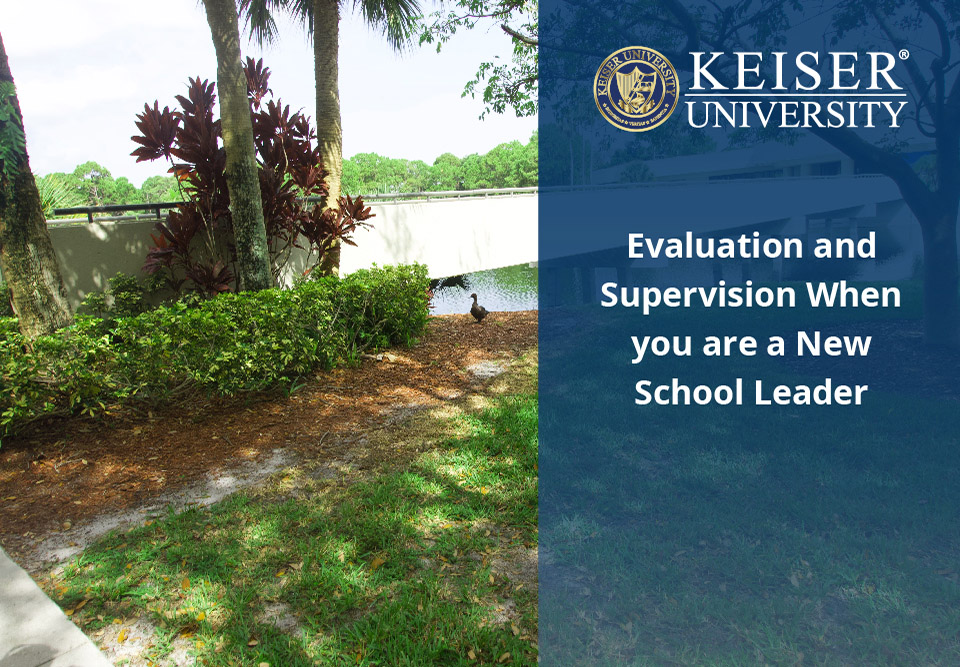New principal evaluation can be an intimidating prospect. You have just acquired your position as the new school principal, and you know you are tasked with supervising school staff and evaluating teachers. While you want to make a good impression, you also need to be able to perform fair and effective evaluations to ensure that students are enjoying the learning experience that they deserve and that teachers are achieving their professional benchmarks.
Exploring the role of evaluation and supervision in school settings can help you develop an approach that allows you to be fair, objective and effective when evaluating teachers and other school staff members.
What Is the Purpose of Supervision and Evaluation in Schools?
For teachers, evaluation can feel like a daunting prospect. It is challenging to have your administrator watching you as you teach a lesson to your class, particularly knowing that anything can happen at any time that can upend your lesson and impact your overall evaluation. However, evaluation is a crucial component in the educational system today, as it ensures that all students have access to high-quality and effective educators.
Teacher quality has a direct impact on student outcomes, and administrators are responsible for supervising teachers to ensure that students are receiving a relevant and equitable educational experience.
Key Responsibilities of a School Leader in Supervision
New school leaders should employ a blend of strategies to fairly and effectively evaluate teachers. Observe the teacher and evaluate:
- His or her mastery of content.
- His or her mastery of methodology.
- His or her mastery of classroom management skills
- His or her methods of interpersonal interaction with students and peers.
Above all, new school principals need to make sure that they have created a clear evaluation structure that will be consistently applied to all educators and staff members in the building. The evaluation process needs to be transparent, so that teachers know that they are being evaluated fairly when compared to their peers in the building.
Challenges New School Leaders Face in Supervision
Even when conducting a consistent and fair new principal evaluation, you may find that you face unexpected challenges that can compromise the integrity of the evaluation. Some challenges that new school leaders face during the evaluation process include:
- Accommodating a diverse range of teaching styles and recognizing that each individual teacher has their own approach.
- Weighing the classroom dynamics and the needs of the students in the classroom population as part of the evaluation.
- Understanding and accounting for teacher anxiety, as it can be stressful for teachers to be observed while they are giving a lesson.
Best Practices for Effective Supervision as a New School Leader
As a new school principal, you will need to strike the balance between observing and monitoring your staff while also giving them the freedom to do their jobs and do them well. School administrators are tasked with not only providing their educators and staff members with ongoing support, but also being empathetic to and understanding of the complex challenges that arise in today’s modern educational landscape.
These are some of the best practices for effective supervision in educational settings:
Observing and Providing Constructive Feedback
Some researchers note that observations do not always have to be formal evaluations. They can simply be opportunities to build rapport between the teacher, the team, and the administration. Principals can observe and offer confirmatory or coaching commentary to help build teacher confidence and skills throughout the year so that the experience of formal evaluations is less stressful.
Establishing a Supportive and Transparent Evaluation Process
Above all else, the evaluation procedures and protocols that you put in place should be designed to provide educators with support, not to add additional stress and anxiety to an already challenging position. You should create a transparent, objective and fair evaluation process that all teachers can access, so that they understand how they are being evaluated. Your teachers need to feel confident that they are being evaluated fairly when compared to their coworkers in the building.
Creating a Collaborative Professional Development Plan
By working with the teachers and staff members in your organization, you can create a collaborative professional development plan that allows everyone to have input in the evaluation and supervision process. When your staff members feel seen, heard and acknowledged, you can earn their respect and develop a cohesive working relationship.
Building Positive Relationships with Faculty and Staff
While the evaluation process is an important part of your role as a new school principal, you also need to focus on building positive relationships with faculty and staff members throughout the entire school year. By coaching and mentoring throughout the year. and showing your staff appreciation on a regular basis, you will be able to create a positive relationship that is rooted in mutual respect. Through relationship development, you can make the process of evaluation and supervision easier and more effective.
Supervision and Evaluation Models for School Leaders
As a new school leader, you can build your own approach to supervision and evaluation by relying on the models that have proven effective in educational settings for many years. Understanding the traditional and modern approaches to evaluation and supervision can help you create a strategy that feels right for you, and will best work within your school building.
Traditional vs. Modern Supervision Approaches
When it comes to theories and methods of school supervision and evaluation, most schools or even entire school districts will adopt a specific model that administrators should use when evaluating staff members. Some of the more traditional and conventional approaches to school supervision include the bureaucratic model and the scientific management approach. The bureaucratic model is a hierarchical structure, and it is commonly used in large school buildings and districts. The scientific management approach emphasizes the importance of data analysis in evaluation, and it requires administrators to directly supervise educators to improve data-driven instruction within the building.
Popular Teacher Evaluation Models
Today, some of the more popular teacher evaluation models are rooted in convention. However, they also weave leadership models into the structure to provide more flexibility. Some of the most popular teacher evaluation models today include:
Danielson Framework for Teaching
The Danielson Group defines the Danielson Framework for Teaching as a model that provides teachers with a common language that they can use to provide high-quality, differentiated instruction for a wide range of students. The hallmark of this framework is that it is constantly evolving to accommodate the shifting nature of today’s educational landscape, giving teachers ongoing support as they continue to strive to meet the needs of all of their students.
Marzano Teacher Evaluation Model
The Marzano Teacher Evaluation Model focuses on 23 core competencies that teachers need to prioritize to effectively educate all students within a classroom setting. This model incorporates the latest educational research to provide school leaders with a framework that can be used to ensure that teachers are being creative and forward-thinking in the classroom setting.
The 5D+ Teacher Evaluation Rubric
The 5D+ Teacher Evaluation Rubric is one of the most widely-used models among school administrators, largely because it focuses on 30 key performance indicators that shed insight into teacher performance and effectiveness in the classroom. The rubric is broken down into several categories, including purpose, student engagement, curriculum and pedagogy, assessment for student learning and classroom environment and culture, providing a comprehensive overview of a teacher’s effectiveness in the classroom.
Performance-Based Assessments for Educators
Performance-based assessments for educators are often used when principals need to collect and publish data related to effectiveness within the school. While performance-based assessments for educators are becoming increasingly common, school leaders and administrators need to consider organic factors as well when evaluating their staff members.
Addressing Common Evaluation and Supervision Challenges
Evaluations are stressful for the teachers being observed in the classroom and can be daunting for the school principals tasked with completing them and providing feedback. Recognizing that there are challenges associated with school evaluations and creating thoughtful solutions in advance can help you more easily navigate these issues when they arise.
Some of the common evaluation and supervision challenges for new school leaders include:
Handling Underperformance and Difficult Conversations
It can be difficult to tell a teacher they are underperforming in the classroom. School principals can handle these challenging conversations by:
- Offering data-based insight into the teacher’s performance.
- Remaining empathetic and understanding.
- Setting clear benchmarks the teacher needs to reach and offering support along the way.
Navigating Resistance to Feedback and Change
Not surprisingly, some teachers are resistant to the feedback that they receive, particularly if they feel as if they are under attack by school leadership. You can navigate this resistance to change by:
- Actively working to build trust among your staff members prior to beginning evaluations.
- Framing feedback in a positive way so as not to make the teacher feel defensive.
- Offering personalized guidance along with feedback so that the teacher feels supported.
Frequently Asked Questions (FAQs)
Q1: What is the most effective teacher evaluation model for new school leaders?
A: Consider: Charlotte Danielson, Kim Marshall, and Robert Marzano offer widely used processes and models for assessing teaching effectiveness with structured, research-based criteria.
Q2: How can a new school leader build trust with teachers while evaluating them?
A: Open communication, constructive feedback and a focus on growth rather than punishment help establish trust and collaboration.
Q3: How often should evaluations and feedback sessions occur?
A: Regular classroom observations, informal check-ins and structured annual evaluations ensure continuous improvement.
Interested in Becoming a New School Principal? Explore the Advanced Education Degrees at Keiser University Graduate School
To develop the advanced skills required for new school leader supervision, you will want to pursue a graduate degree that allows you to become proficient in leadership techniques for school management. At Keiser University Graduate School, we offer a wide range of education graduate degrees, including an Education Specialist in Educational Leadership degree, a Doctor of Education degree and a Doctor of Philosophy in Educational Leadership degree. All of these programs will allow you to learn how to perform new leader evaluation and guide school staff toward their goals.
Contact a graduate admissions counselor today to learn more about our education graduate degree programs.






 The instructors at Keiser University impacted my life. They believed in my ability to become a great graphic designer, regardless of how I felt about my skills. KU helped to prepare me for the real world and got me to where I am today.
The instructors at Keiser University impacted my life. They believed in my ability to become a great graphic designer, regardless of how I felt about my skills. KU helped to prepare me for the real world and got me to where I am today.
